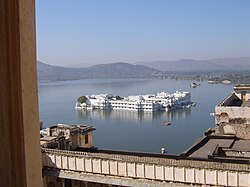
Udaipur city in Rajasthan state has five major lakes (not to be confused with Udaipur Lake in Bihar), as listed below, which are under restoration with funds provided by the National Lake Conservation Plan (NLCP) of the Government of India. [1]

Udaipur city in Rajasthan state has five major lakes (not to be confused with Udaipur Lake in Bihar), as listed below, which are under restoration with funds provided by the National Lake Conservation Plan (NLCP) of the Government of India. [1]

